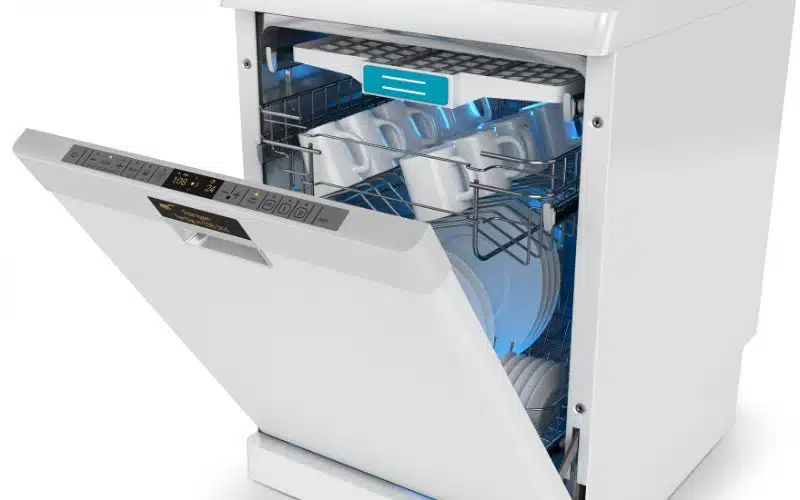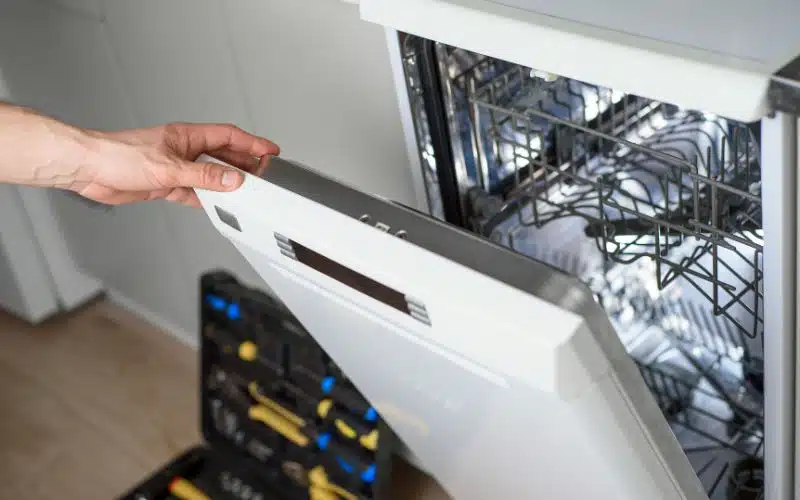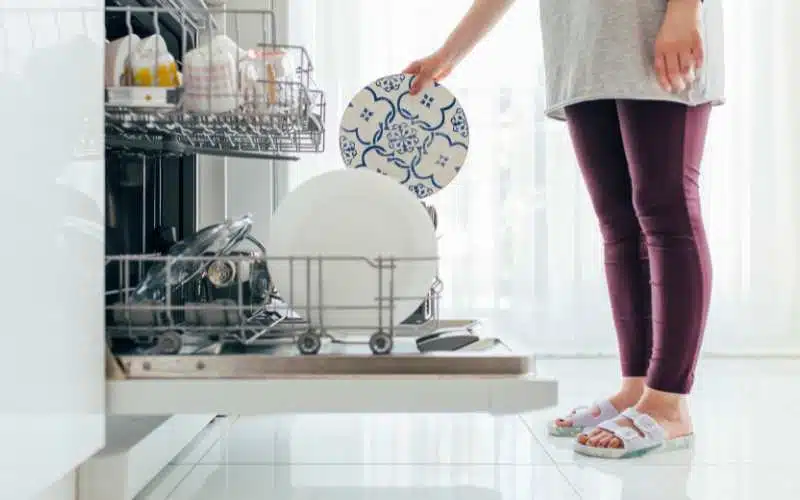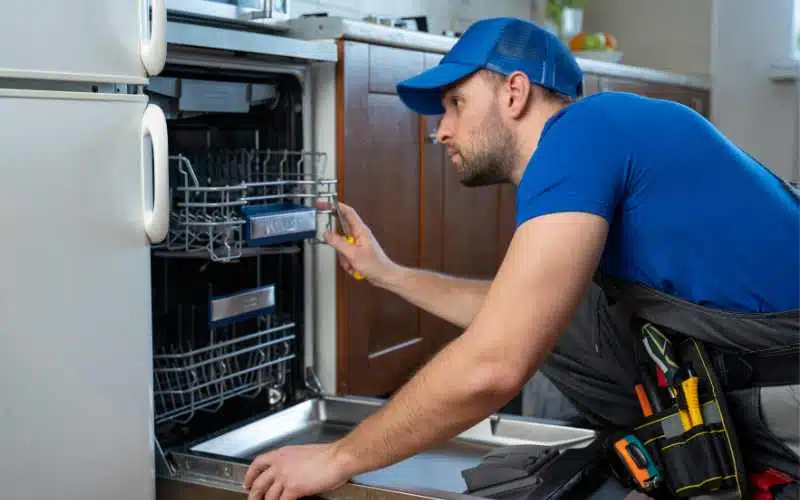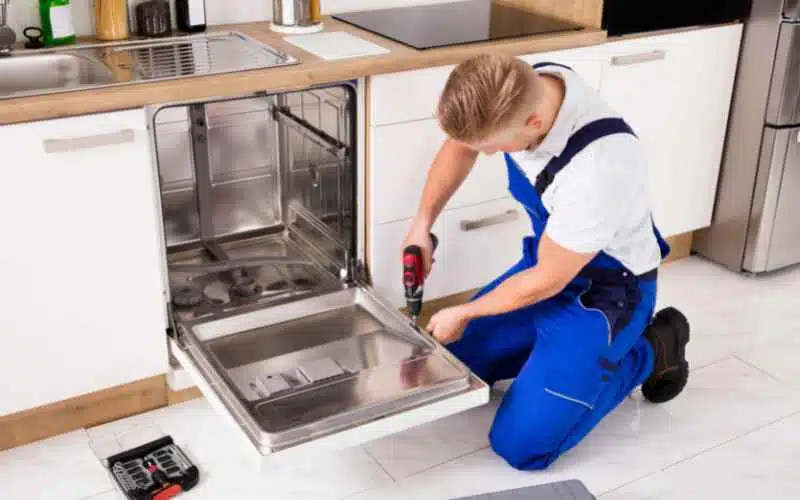Dishwashers are spacious, well-sized appliances that contain racks where the plates sit during the wash cycle. First, water enters the dishwasher via the water hose.
Next, the hose is extended from the water inlet valve, connected to the spigot handle underneath the kitchen sink.
Consequently, the water enters at a specific pressure for the dishwashing to be effective. Thus, if the water enters at a lower pressure, it may result in some unusually delayed functions.
Hence, the need to know if the dishwasher requires high water pressure or if the pressure of the water does not matter.
Yes, dishwashers require that water enters at the specific pressure of 20-120 pounds per square inch (PSI). The pressure is high enough to fill up the dishwasher. However, the water level is just below the heating components. But, if the pressure is lower than the supposed value, it will lead to several problems.
Do You Need Good Water Pressure For a Dishwasher?
Of course, you need an amount of pressure that is enough to fill up the dishwasher timely. Below are various reasons why a good enough pressure is necessary for a dishwasher.
#1. It Helps To Thoroughly Clean The Dishes
Water flows from the water source to the shut-off valve underneath the sink. Consequently, it flows through the water inlet valve and into the dishwasher.
However, when the water pressure is low, the water does not fill up the dishwasher.
As a result, the plates stationed in the top rack of the dishwasher might not get enough water during the cycle.
#2. It Stops Prolonged Wash Cycles
Low water pressure takes longer for the water to flow in before cleaning begins. But, of course, if the water does not fill up the dishwasher, the result is a prolonged cycle.
But, if the water pressure is high enough to allow the normal flow, the cycle duration will be as it should.
Hence, there will be no unusual cycle durations, and the dishes will be squeaky clean afterward.
How Much Water Pressure Does a Dishwasher Need?
An average dishwasher needs between 20 and 120 pounds per square inch (psi) and above 130 degrees Fahrenheit.
This pressure is just enough to help the dishwasher function properly. Anything less than the standard will lead to a half-closed water inlet valve, hence, a leaking dishwasher.
Although, there might be other faults associated with low water pressure like:
Extremely Long Cycle Duration
One wash cycle is supposed to last for at most four hours. During this cycle, the dishwasher gets filled with water.
Afterward, the water gets heated by the coil to eliminate hardness.
Aside from removing the hardness of the water, it is more suitable for the water to get heated because:
It Cleans Effectively
Hot water is preferable to cold water when washing dishes because the dirt dissolves quickly. In addition, dirt particles will easily lose their bonds with the interference of hot water.
However, this may not be the case with cold water. Thus, the water is heated before washing commences.
Forms Lather Quickly
Hard water does not form lather with soap and needs to be softened by heating. Soft water also aids in an effective wash cycle, making washing faster, easier, and more effective even with minimal detergent.
Hence, soft water is a more suitable choice for washing dishes, and most people prefer it over hard water.
Additionally, hard water contains high sodium content, making it impossible for glassware to be shiny even after rinsing correctly.
Therefore, soft water is a better option for dishwashing.
Eliminates Microorganisms
Stale food particles usually ferment due to microorganisms’ activity. Unfortunately, most of these germs thrive in cold water or humid temperatures.
However, they will become inactive as the water gets warm.
It Is The Best Solution To Remove Grease
Greasy plates are unavoidable due to the amount of oily or fatty foods we consume. Washing with hot water breaks down the bonds formed by fatty acids as the water reacts with the detergent.
So, it is safe to say that hot water is the best for having non-greasy glassware.
How To Check Water Pressure For a Dishwasher?
You can check the water pressure by taking note of the cycle duration. The process involves confirming if the water pressure is high or low.
Granted that the pressure is sufficient, the wash cycle will not take a longer time than usual.
If the overall water pressure in your house is low, the pressure coming into your dishwasher will also be below.
Another way to check the water pressure is by checking the pressure gauge in your house.
However, this could only be possible if you have an installed pressure gauge.
But, if you don’t have that available, you can follow these steps that show how to check your overall water pressure.
#1. Materials.
- A pressure gauge
- An adjustable wrench
The pressure gauge is to check the pressure during the process. The adjustable wrench is to adjust the pressure gauge while connecting it to the faucet.
Although there are different types, you need to have the right set of wrenches.
#2. Turn Off All Water Outlets
Firstly, turn off all the outlets that distribute water. To be able to measure the pressure uniformly.
#3. Connect The Pressure Gauge
Afterward, locate a faucet and connect the pressure gauge directly to the outlet. Use the wrench to adjust the connectable end of the pressure gauge to avoid leaks.
If it’s tightly secured, there will be no leakage. Turn on the tap to allow the water to rush in and the pressure to flow uniformly.
Make sure that the pressure gauge is aligned so that you can read the pressure at eye level.
#4. Take Your Reading
Now, look at the gauge and take your readings. Normal water pressure for a house is still around 20 to 120 (PSI). Of course, if the pressure is low, it indicates a leakage somewhere.
Can You Run a Dishwasher With Low Water Pressure?
No, it is futile to attempt to run your dishwasher when the water pressure is low. Instead, here are factors that cause decreased water pressure.
#1. Clogged Drain
Check the drain hole routinely for food particles that might be stuck there. Either as a result of sloppily scrapping food particles before placing the plates in the dishwasher.
When these particles are present during washing, they may clog the drain.
Subsequently, a clogged drain does not allow water to flow out of the dishwasher on time.
Eventually, the cycle duration will take longer, and the plates might not be clean.
#2. Torn Water Hose
The water hose is directly connected to the water inlet valve and supplies water to the dishwasher. If it gets torn, the pressure will be lower, making the water flow in trickles.
Consequently, the dishwasher will take a longer time for water to flow. The solution is to replace the hose for the pressure to be back to normal.
#3. Faulty Water Supply Valve
Additionally, if the water supply valve is faulty, there will be a step down in the pressure. If this happens, the only solution is to replace the valve with a new one.
Upon replacement, the pressure should return to the standard, and dishwashing, back to normal.
How To Increase Water Pressure In a Dishwasher?
You can manually increase the water pressure in your dishwasher when it’s too low by following these steps.
#1. Disconnect From Power Source
Before proceeding further with any step, disconnect the dishwasher from the power source.
You can either unplug it from the socket, turn off the circuit breaker in the kitchen, or put off the power button.
#2. Turn Off The Water Supply
Aside from turning off the power source, you also have to disconnect the water supply to the dishwasher.
You can turn this off by fully turning the handle underneath your kitchen sink. If you fully turn it off, you have stopped the water flow.
#3. Locate The Water Heater and Pressure Switch
The water heater is just underneath the dishwasher’s panel, and the water supply valve is attached to the heater.
Here, you will also find a switch that controls the pressure of the water entering the dishwasher. Uncover the pressure switch before attempting to adjust the water pressure.
#4. Adjust and Reassemble
Using a Torx screwdriver, twist the adjustment screw to the left direction. Of course, you can purchase the Torx screwdriver set without a hassle.
Turning it counterclockwise means that the pressure increased. However, if you turn it clockwise, the pressure is reduced.
Afterward, screw the switch and the panel back in place, and the pressure will return to the appropriate standard.
Final Thoughts
A dishwasher does not need pressure higher than 120 pounds per square inch (PSI). The standard pressure is required for it to function effectively.
However, if the pressure is any lower than this, the cycle duration will be prolonged, amongst other things.
So, it’s safe to say that low water pressure is not appropriate for a dishwasher.
